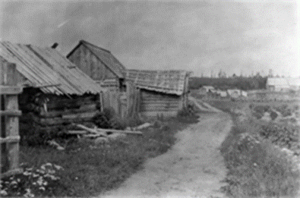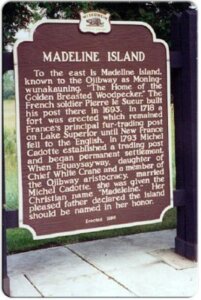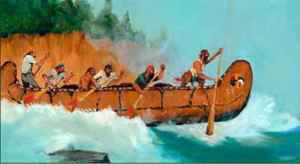Michel and Equaysayway Cadotte:
Michel and Equaysayway Cadotte:
A Power Couple of the Fur Trade
Tina Annett
Port2Port - 2025
Michel Cadotte and Equaysayway Cadotte were an extraordinary couple whose union bridged two distinct cultures and played an important role in the fur trade around southwestern Lake Superior during the eighteenth century. Their marriage was not just a personal bond but a blending of French Canadian and Ojibwe traditions that left a lasting impact on the region's history. Michel Cadotte, born in Sault Ste. Marie, Michigan, came from a Métis family with a long-standing involvement in the fur trade, making him well-suited for the industry that drove the Great Lakes economy. His father, Jean Baptiste Cadotte, Sr., was French Canadian, while his mother, Athanasie, was Ojibwe, giving Michel a dual cultural heritage. Equaysayway, his wife, was the daughter of Chief White Crane, a respected leader of the Ojibwe people.1 Their marriage, which took place around 1787 under Ojibwe tradition, symbolized the merging of their cultural strengths. The approximate date of their union is unsurprising, given the Ojibwe custom of preserving important events through oral history.2 Figure 1 shows the probable site of Michel Cadotte's house3 where, with Equaysayway, would go on to have at least 13 sons and 9 daughters. 4

Figure 1: Probable Site of Michel Cadotte's House
It wasn't until about 40 years later that they married in a Catholic church. This was a direct response to changes in the law, as Wisconsin determined that marriages performed only by Indigenous custom were not legally valid.5 This transition to a Catholic marriage highlights the couple's ability to adapt to changing societal norms while still honoring their original union, all while supporting their family business. The couple settled on Madeline Island, now part of Wisconsin, USA. The island held significance to both Michel and Equaysayway because it was named by Chief White Crane in honor of Equaysayway's English name, Madeline The island became a central hub for their fur trade business, as seen in figure 2 by the plaque dedicated to the Cadottes.6 Michel and Equaysayway's presence on the island was not just about their family, but about creating a thriving economic center that benefited the French Canadians, Métis, and the Ojibwe people.7

Figure 2: Dedication Plaque to the Cadottes
Equaysayway was much more than just Michel's wife; she was an essential partner in their business endeavors and took part in fur trading voyages. As a member of the Ojibwe community, she brought substantial social and cultural capital to the relationship.8 Her connections to the local Indigenous population, knowledge of the land, and understanding of trade practices were important assets that significantly contributed to Cadotte's success in the fur trade. Figure 3 represents what their trading voyage may have looked like naviugating the waters of Lake Superior.9 By bridging the gap between French Canadian traders and the Ojibwe community, Equaysayway ensured that their business flourished.

Figure 3: Early Voyageur Fur Traders on Lake Superior
Her ability to navigate both worlds allowed Michel to access resources, establish relationships, and operate in areas that would have been much more challenging without her influence. Michel and Equaysayway Cadotte were not just a couple; they were pioneers, and visionaries, and continue to be an enduring symbol of what can be achieved when diverse cultures come together in peace.
-
Michael G. Johnson, Ojibwa People of the Forests and Prairies, Firefly Books (2016). ↩
-
Robert Silbernagel, The Cadottes: A Fur Trade Family on Lake Superior (Madison: Wisconsin Historical Press, 2020). ↩
-
Figure 1: [Probable Site of Michel Cadotte's House], photograph, Wisconsin Historical Society, n.d. ↩
-
John P. DuLong, "Jean Baptiste Cadotte's First Family: Genealogical Summary -- Part One," Michigan's Habitant Heritage 41, no. 4 (2020). ↩
-
Silbernagel, "The Cadottes," 45. ↩
-
Figure 2: [Dedication Plaque to the Cadottes], photograph, The Canadian Encyclopedia (2020). ↩
-
Unknown Author, Cadotte, Michael, 1764-1837, Wisconsin Historical Society, n.d. ↩
-
Silbernagel, "The Cadottes," 92. ↩
-
Figure 3: [Early Voyageur Fur Traders on Lake Superior], illustration, Madeline Island School of the Arts, n.d. ↩

